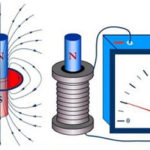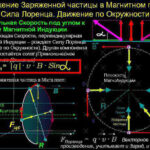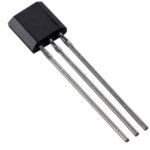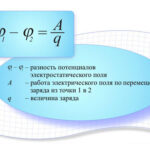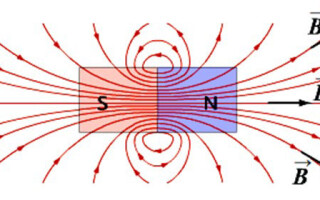A special form of matter existence, the Earth's magnetic field contributed to the origin and preservation of life. Shards of this field, pieces of ore that attracted iron, brought electricity in the service of mankind. Without electricity, survival would be unthinkable.
Contents
What are magnetic induction lines
The magnetic field is defined by the strength at each point in its space. The curves joining the points in the field of equal modulo intensities are called magnetic induction lines. The magnetic field strength at a particular point is a force characteristic, and the magnetic field vector B is used to estimate it. Its direction at a particular point on the magnetic induction line is tangential to it.
In case a point in space is affected by several magnetic fields, the strength is determined by summing the magnetic induction vectors of each acting magnetic field. In this case, the strength at a particular point is summed up modulo, and the magnetic induction vector is defined as the sum of the vectors of all magnetic fields.
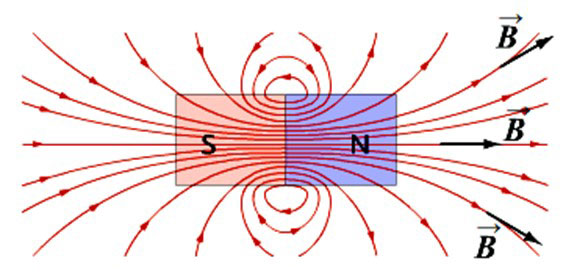
Despite the fact that magnetic induction lines are invisible, they have certain properties:
- It is accepted that the magnetic field lines of force exit at the pole (N) and return from (S).
- The direction of the magnetic induction vector is tangential to the line.
- Despite the complex shape, the curves do not intersect and are necessarily short-circuited.
- The magnetic field inside the magnet is homogeneous and the line density is maximal.
- Only one magnetic induction line passes through a point in the field.
Direction of magnetic induction lines inside a permanent magnet
Historically, the natural quality of certain stones to attract iron objects has long been noticed in many places on Earth. Over time, in ancient China, arrows carved in a certain way from pieces of iron ore (magnetic iron ore) have turned into compasses, showing the direction to the north and south pole of the Earth and allowing to navigate the area.
Studies of this natural phenomenon have determined that iron alloys retain their stronger magnetic property longer. Weaker natural magnets are ores containing nickel or cobalt. In the process of studying electricity, scientists learned how to obtain artificially magnetized items from alloys containing iron, nickel or cobalt. To do this, they were introduced to a magnetic field created by a direct electric current and, if necessary, demagnetized by alternating current.
Products magnetized in nature or artificially produced have two different poles - the places where magnetism is most concentrated. Magnets interact with each other by means of a magnetic field in such a way that the poles of the same name repel and the poles of different names attract. This forms rotating moments for their orientation in the space of stronger fields, such as the Earth's field.
A visual representation of the interaction of weakly magnetized elements and a strong magnet gives a classic experience with steel filings scattered on cardboard and a flat magnet under it. Especially if the sawdust is oblong, you can clearly see how they line up along the magnetic field lines of force. Changing the position of the magnet under the cardboard changes the configuration of their image. The use of compasses in this experiment further enhances the effect of understanding the structure of the magnetic field.

One of the qualities of magnetic field lines, discovered still by M. Faraday suggests that they are closed and continuous. The lines coming out of the north pole of the permanent magnet enter the south pole. However, inside the magnet they are not disconnected and enter from the south pole into the north pole. The number of lines inside the piece is maximum, the magnetic field is homogeneous, and the induction can become weaker when demagnetized.
Determining the direction of the magnetic induction vector using the rule of the drill
In the early 19th century, scientists discovered that a magnetic field is created around a conductor with current flowing through it. The resulting lines of force behave according to the same rules as with a natural magnet. More importantly, the interaction between the electric field of a conductor with a current and the magnetic field served as the basis for electromagnetic dynamics.
Understanding the orientation in space of the forces in the interacting fields allows us to calculate the axial vectors:
- Magnetic induction;
- Magnitudes and directions of induction current;
- Angular velocity.
This understanding was formulated in the rule of the boravnik.
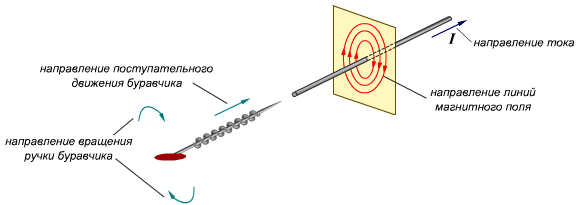
By combining the translational motion of the right-handed boravnik with the direction of the current in the conductor, we obtain the direction of the magnetic field lines, which is indicated by the rotation of the crank.
Not being a law of physics, the rule of the Buravnik in electrical engineering is used to determine not only the direction of the magnetic field lines depending on the vector of current in the conductor, but on the contrary, to determine the direction of current in the solenoid wires in connection with the rotation of magnetic induction lines.
Understanding this relationship allowed Ampere to substantiate the law of rotating fields, which led to the creation of electric motors of various principles. All pulling equipment that uses inductance coils follows the rule of the borax.
The right-hand rule
Determining the direction of the current moving in the magnetic field of a conductor (one side of a closed coil of conductors) clearly demonstrates the rule of the right hand.
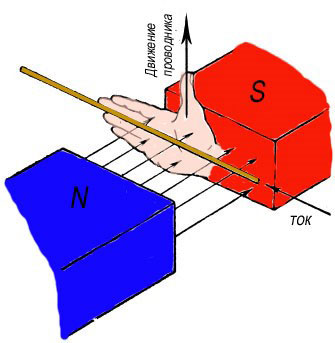
It says that the right palm turned to the pole N (power lines enter the palm), and the thumb deflected by 90 degrees shows the direction of the conductor, then in a closed loop (coil) the magnetic field induces an electric current, the vector of motion of which is indicated by four fingers.

This rule demonstrates how direct current generators originally appeared. Some force of nature (water, wind) rotated a closed loop of conductors in a magnetic field generating electricity. Then motors, having received electric current in a constant magnetic field, converted it into mechanical motion.
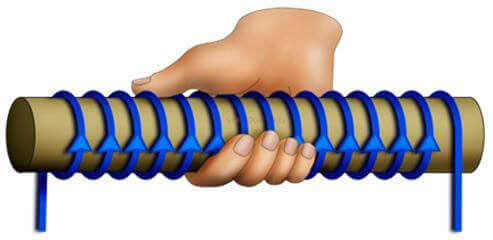
The right-hand rule is also true in the case of inductance coils. The movement of a magnetic core inside them leads to induction currents.
If the four fingers of the right hand are aligned with the direction of current in the coils of the coil, then the thumb, deflected 90 degrees, will point to the north pole.
The rules of the boravnik and right hand successfully demonstrate the interaction of electric and magnetic fields. They make understanding the operation of various devices in electrical engineering accessible to almost everyone, not just scientists.
Related articles:
